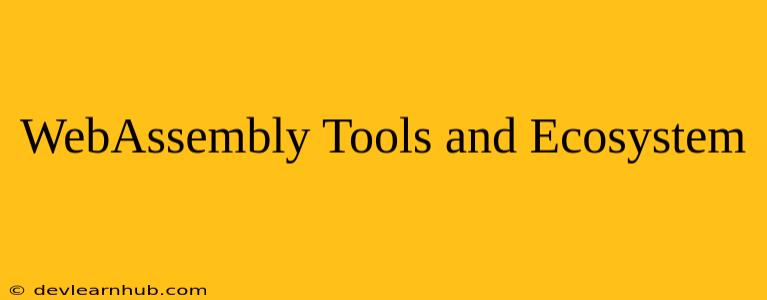WebAssembly (Wasm) has emerged as a game-changer in the world of web development, offering a powerful and efficient way to execute code in the browser. But the true potential of WebAssembly lies not just in its technical capabilities, but also in the vibrant ecosystem of tools and resources that empower developers to build and deploy high-performance web applications. In this comprehensive guide, we will delve into the essential tools and resources that form the foundation of the WebAssembly ecosystem.
The Building Blocks of WebAssembly Development
1. Compilers and Transpilers
At the heart of the WebAssembly workflow lie compilers and transpilers that convert code written in various programming languages into Wasm bytecode.
- Emscripten: A widely-used compiler that supports languages like C, C++, and Python, making it a bridge for bringing existing codebases to the web.
- AssemblyScript: A TypeScript-based compiler that provides a familiar syntax and a robust type system, simplifying the transition for JavaScript developers.
- Rust: The Rust programming language offers a powerful and memory-safe environment for developing Wasm modules.
- Clang/LLVM: The LLVM compiler infrastructure is a versatile tool for compiling Wasm from various languages, including C, C++, and Fortran.
2. Development Environments and Editors
Efficient development demands a supportive environment and powerful tools.
- Visual Studio Code (VS Code): This popular editor boasts extensive WebAssembly support through extensions like "WebAssembly" and "WASM Language Support."
- WebAssembly Studio: A dedicated web-based IDE designed specifically for WebAssembly development, offering an integrated workflow for compiling, testing, and debugging.
- VSCode WSL: Combining the power of Visual Studio Code with the Windows Subsystem for Linux (WSL) enables seamless development in a Linux environment for better compatibility with Wasm tools.
3. Debugging Tools
Debugging is an essential part of the development process, especially for complex Wasm applications.
- Wasm Debugger: A powerful command-line tool that provides comprehensive debugging capabilities for WebAssembly modules, enabling developers to inspect variables, step through code, and identify issues.
- Browser Developer Tools: Modern browsers offer built-in debugging tools, including support for Wasm, allowing developers to inspect memory usage, analyze code execution, and track performance metrics.
- Wasm-Bindgen: A tool that assists in generating bindings between JavaScript and WebAssembly modules, simplifying integration and interoperability.
The WebAssembly Ecosystem in Action
Beyond the core tools, the WebAssembly ecosystem is a thriving landscape of resources and frameworks that facilitate development and deployment.
1. Libraries and Frameworks
- WASM-Bindgen: A tool that assists in generating bindings between JavaScript and WebAssembly modules, simplifying integration and interoperability.
- Wasmer: A runtime environment for executing Wasm modules, providing a platform for deploying Wasm applications in various environments.
- WASI (WebAssembly System Interface): A standardized interface that enables WebAssembly modules to interact with the operating system and its resources, opening doors for a wider range of applications.
2. Communities and Resources
- WebAssembly Community: An active online forum where developers can share knowledge, collaborate on projects, and engage in discussions.
- WebAssembly Specifications: The official documentation and specifications for WebAssembly, providing a comprehensive reference for developers.
- WebAssembly Blog: A dedicated blog that keeps developers informed about the latest advancements, best practices, and emerging trends in the Wasm ecosystem.
Beyond the Basics: Advanced Techniques
The WebAssembly ecosystem continues to evolve, offering advanced techniques that push the boundaries of what's possible.
1. WebAssembly Threads:
Multi-threading in WebAssembly enables parallel execution, unlocking significant performance gains for tasks that can be broken down into independent threads.
2. WebAssembly Components:
WebAssembly Components provide a modular approach to building WebAssembly applications, allowing developers to create reusable components that can be easily combined to build complex applications.
3. WebAssembly Interface Types:
Interface types define the shape and behavior of WebAssembly modules, enhancing code reusability and promoting interoperability between different modules.
Conclusion: The Future of WebAssembly
The WebAssembly ecosystem is a vibrant and dynamic space that empowers developers to build powerful and efficient web applications. With a growing array of tools, libraries, and frameworks, WebAssembly is rapidly expanding its reach, revolutionizing web development and unlocking a new era of performance and innovation. As the ecosystem continues to mature, we can expect even more exciting advancements and applications to emerge, shaping the future of the web as we know it.
